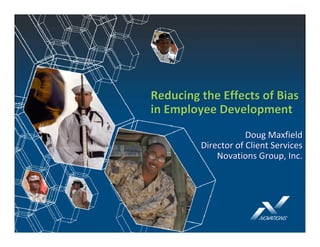
Reducing the Effects of Bias in Employee Development
- 1. Reducing the Effects of Bias in Employee Development Doug Maxfield Director of Client Services Novations Group, Inc.
- 2. Many reasons are used to promote the increase of diversity in the workplace. n Decreas atio e in nov grou d in y an p-th tivit ink Crea cs aphi ogr Right thing to do g dem gin Chan Repres Improve e nt popu d team l ation perf ormanc e g olvin robl em s p ved I mpro
- 3. Diversity does not necessarily mean high performance. Diverse organizations aren’t necessarily inclusive. Inclusive organizations aren’t necessarily diverse. Diverse organizations do not necessarily out-perform non-diverse organizations. Well-managed and inclusive organizations that are diverse often out-perform non-diverse and poorly managed organizations.
- 4. FOUR STAGES of CONTRIBUTION
- 5. Learner
- 6. Expert
- 7. Influencer
- 8. Strategist
- 9. Value depends on contribution. 4 A GE 3 ST VALUE 2 1 CONTRIBUTION
- 10. Key findings of recent study. High performers continuously increase their capacity and contribution. A significantly greater percentage of Caucasian employees are rated as contributing beyond Stage 1. Women are on par with men for Stage 3 contribution as a percent of the population, but fewer in Stage 4. Gender and ethnicity differences can affect perceptions of contribution.
- 11. Managers and their direct reports differ in their assessment of contribution… Mean Dominant Stage 2.50 2.00 1.50 1.90 2.38 1.00 0.50 0.00 Manager Rating of Direct Report Direct Report Rating of Self
- 12. …but the gap tends to be larger between managers and direct reports of color. 40 40 Percentage Gap in Perception of Contribution Percentage Gap in Perception of Contribution 30 30 20 20 White/Caucasian White/Caucasian 10 10 Black/AA Black/AA Hispanic/Latino Hispanic/Latino 0 0 Asian Asian -10 -10 -20 -20 Stage One Stage Two Stage Three Stage Four -30 -30
- 13. Differences in specific competency ratings suggest potential reasons for these differences in perception. Competency/Behavior Possible Explanation Strategic Alignment Learning vs. understanding how American managerial work relates to strategy stereotypes Learns from Experience Asking questions Dependency vs. protective device to lower risk Gaining input first then building draft vs. building draft then Cultural differences in gaining input consensus building
- 14. The “perception gap” impacts positioning by manager and disposition of direct report. Position Disposition The degree to which an The degree to which an individual individual’s demonstrates the assignments and support necessary confidence, represent platforms for determination, and learning. commitment.
- 15. Logic drives the manager’s treatment and the employee’s behaviors. Manager’s Positioning Employee’s Disposition Provides only portions Waits for direction, of a project and direct seeks supervision supervision Seeks only basic skills- Can accomplish routine based contribution tasks Seeks “directed” creativity and initiative Not really innovative Stage One Stage One
- 16. Manager positioning can significantly limit employee development. Initial Employee Initial Employee Manager Positioning Manager Positioning Resulting Disposition Resulting Disposition Disposition Disposition Wants assignments Wants assignments Values specialization Values specialization Focuses effort in Focuses effort in that broaden that broaden and technical depth and technical depth narrow technical area narrow technical area perspective perspective Rewards individual Does not share ideas Does not share ideas Rewards individual Shares ideas and Shares ideas and results or “credit” or “credit” results knowledge with others knowledge with others Views coaching of Views coaching of Aspires to develop Assigns sole Assigns sole others as non value- Aspires to develop others as non value- others as mentor or responsibility for responsibility for add others as mentor or add idea leader definable projects definable projects idea leader Limits network and Limits network and Seeks to build strong Seeks to build strong Limited sharing of Limited sharing of interactions to those in interactions to those in internal and external internal and external network contacts and network contacts and immediate sphere of immediate sphere of networks networks exposure to others exposure to others work work Stage Three Stage Two Stage Two
- 17. Mind the
- 18. Consciously broaden the pool of
- 19. Expect consistent outcomes …from a diversity of approaches
- 21. Summary Leverage exists in the manager-employee relationship. A roadmap increases ability to articulate development and performance expectations. Resource limitations necessitate the development of all. Provide additional support for key transitions.
- 22. Reducing the Effects of Bias in Employee Development Doug Maxfield 209.834.1863 dmaxfield@novations.com